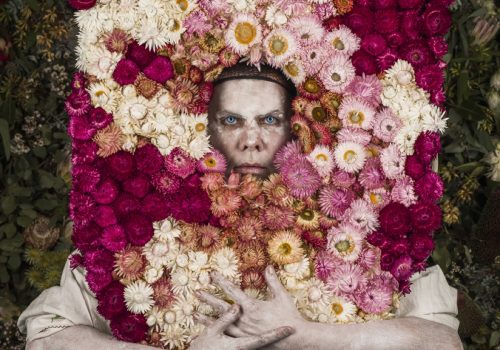Christian Thompson’s digital photographic prints made over the previous decade could be stills from a morality play in which he performs the sole protagonist. Composed as overtly poetic allegories with quixotic themes from the comedic to the mock tragic, they are thick with suggestion and references and ever open to interpretation. Arguably the oldest performance genre, solo story-tellers featured prominently in traditions as different as the tribal oracle and medieval travelling troubadour, and were even extraordinarily popular in Victorian entertainment – all periods that Thompson’s work references.
In his most recent series, Equinox (the equinox is when the sun shines equally on the earth’s northern and southern hemispheres), he plays a spirit figure that in each print is posed with Thompson’s signature baroque regalia. As if the burden of prophecy has left them resigned to the sad fate of humanity, these spirit figures are too lost in melancholic thought to notice us gallery spectators. This transcendental affect transforms the gallery into the pious space of the cathedral where we mortals seek atonement for our sins. One spirit ascends into the clouds, one is beatified in a halo of everlasting daisies that it wears like a large mask and another seemingly drowns in a sea of Australian natives. The other three prints are framed by proteas that blaze from the dark sky like Van Gogh’s stars, their hair tossed (I imagine) by the winds of an approaching storm.
Cradled in their hands are the masks of three bearded besuited Victorian gentlemen, cut out from nineteenth-century prints. What, you wonder, is the moral of this play?
The proteas would seem an Australian reference, but since this plant is native to the ancient giant continent of Gondawana the protea is truly cosmopolitan – a native with roots in the three continents that now form the southern hemisphere. The masks, their subjects identified in the title of the work, are of German colonist made good in the British colonies of New South Wales and Victoria. They will be obscure to most contemporary audiences: Bernhardt Otto Holtermann, a colonial politician and sponsor of photography but best known for the Holterrmann Nuggett, the largest lump of gold embedded in quartz in the world (which is pictured in two of the works); the botanist Baron Sir Ferdinand Jacob Heinrich von Mueller; and the explorer Ludwig Leichardt. Each played a central role in building different aspects of the Australian colonial archive. As in Thompson’s earlier series, Museum of others (2016), the masks have had their eyes cut out, except that the masks are too absurdly doll-like to mask anything. Perhaps they are another type of mask: a votive figure for the guardian angels to nurse as they pray for the three German souls.
These aren’t the only masks as like a seasoned actor Thompson’s scenarios are a series of maskings and unmaskings. What we make of his rich allegory of baroque masquerade, colonial tales, Freudian and other myth, depends on our own imagination. This is even more the case given Thompson’s protean imagination. Adopting disguises seemingly at will and welcoming conundrums and difference as the necessary ingredients of his imagination, you – and I imagine Thompson – can’t predict what’s coming next.
Professor Ian McLean, 2018
Dr. Christian Thompson AO – Equinox
September 7 – October 27, 2018
Michael Reid Berlin
Ackerstraße 163, D-10115 Berlin, Germany
















